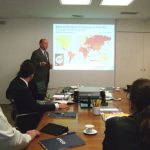Collaboration and communication are essential in implementing compliance programs in companies
Compliance professionals working at ETCO member companies met last Tuesday (23) at the Institute's headquarters in São Paulo (SP) to discuss how to improve their organizations' integrity programs. The workshop, coordinated by ETCO, was led by Create.org's Chief Operating Officer, Craig Moss.
On his second visit to Brazil, the expert says he believes there is growing interest from the organizations installed here in improving compliance practices. This interest has been further motivated by the entry into force of the Anti-Corruption Law (12.846 / 13) in January, and also by the growing internationalization of companies, which in other markets have to follow similar milestones, such as the FCPA (United States) and the UK Bribery Act (United Kingdom).
For the executive, one of the keys to reducing the cost of implementing compliance programs is to collect subsidies from all departments of the company before drafting codes of conduct. HR must also be involved. This department has expertise in communicating with employees that should be used throughout the implementation, the expert understands. Craig also points out that the senior management's commitment to the program is essential for its acceptance in the organization. Only then should the creation of codes of conduct begin, which is generally the first initiative of companies.
Craig notes that the biggest challenge at this stage is making a code of conduct that translates into procedures that are easy for anyone to follow. “It is based on these procedures that the training of employees will be carried out, whose registration and performance must be frequent. Only then will an anti-corruption policy be alive. I know companies around the world that have good compliance policies, with recognition by their CEOs of their importance, but nothing more. So they are unable to have effective programs, ”he says.
Another important point is to carry out a good risk analysis, especially when the company depends on a very large supply chain. “If you have a thousand suppliers to control, you will never be able to pay attention to everyone at the same time. So you need to allocate your resources where the risk is greatest, always making a program consistent with the size of your company, ”says Moss.
The expert believes that compliance should be seen by organizations as a “journey”. Problems can occur even in companies with programs already structured. During the workshop, Moss cited cases from several organizations, and highlighted that of Morgan Stanley, who in 2012 was involved in a bribery scheme in China. The investment bank was able to prove in the American court that it had done everything in its power to curb internal fraud and, therefore, was cleared of the accusations and millionaire fines.
During the event, participants were also able to self-assess their respective compliance programs. “It takes time to progress systematically in each step, but each company has its own needs. You need to know what each one needs, ”says Craig. It ensures that even medium-sized companies can have efficient compliance. “It doesn't have to be complicated or extremely technological. It should only be functional. ”
Check out the Create.org materials below:
Anti-Corruption Compliance: reduce your risks
Guide to improving your Anti-Corruption program
Protection of Intellectual Property and Prevention of Corruption: a new approach





